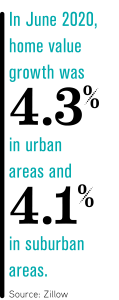As the pandemic forges on, here are some popular home features that are luring homebuyers
By Chasity Cooper
Undoubtedly, 2020 will be the year that turned many (if not all) industries on their heads.
Since March, the world has embraced the new normal of sheltering-in-place, wearing masks when around others in public and attending countless Zoom calls. For CRSs, the coronavirus pandemic has created opportunities to connect with buyers in new ways and close deals quicker than they ever could have imagined.
 Although a “mass exodus” from bustling city centers to open suburban areas has been a reported trend over the last several months, a recent Zillow report shows that, in fact, “suburban housing markets have not strengthened at a disproportionately rapid pace compared to urban markets.” In June 2020, home value growth was 4.3% in urban areas and 4.1% in suburban areas. In other words, the appetite for property in both markets is strong among buyers—which makes it a challenge for supply to keep up with demand.
Although a “mass exodus” from bustling city centers to open suburban areas has been a reported trend over the last several months, a recent Zillow report shows that, in fact, “suburban housing markets have not strengthened at a disproportionately rapid pace compared to urban markets.” In June 2020, home value growth was 4.3% in urban areas and 4.1% in suburban areas. In other words, the appetite for property in both markets is strong among buyers—which makes it a challenge for supply to keep up with demand.
“Home prices are up at unprecedented levels, and the age-old economic law of supply and demand is only one of the main reasons why,” says Richard Borelli, CRS, with Howard Hanna Real Estate Services in Lakewood, Ohio. “Successful agents have had to learn how to prepare their listings to meet buyers’ needs, and many people have realized that with the COVID-19 quarantine, they want and need something different than before.” With interest rates being recorded at historic lows, first-time homebuyers and millennials are also the main drivers in the current real estate market. “These historically low rates are helping buyers and sellers. Buyers can pay more because they can afford more. There has never been a better time to buy,” Borelli says. “It’s also a great time to sell. Low interest rates are providing sellers with more equity than they have seen before because lower rates equate to higher prices paid for homes.”
With an ideal marketplace, what specifically is attracting buyers who are looking for a new place to call home as the pandemic forges on? For starters, buyers want to be able to distinguish where they get work done and where they play.
More than a little elbowroom
“Buyers are definitely looking for more space,” says Jeff Wu, CRS, real estate agent for Keller Williams Capital Properties in Northern Virginia. “As families are continuing to attend work and school remotely, they want to have a home office, or areas dedicated specifically to each activity.” As a father of four, Wu can understand buyers’ need for more space for work and leisure activities. “It can be hard in our homes when the same space is used for multiple things,” says Wu. “It’s kind of crazy to think that the same dining room table that’s used for school is also used for eating dinner, hanging out or playing video games. In contrast, when you go to school, you’re in that building and get into a school mindset. I want my kids to be able to switch gears and be able to focus in the realm that they’re in.”
 Aside from more interior space, buyers are also looking for outdoor amenities that give them room to breathe. From homes in the suburbs with big yards for the kids and pets to condominiums in urban centers with terraces, decks and rooftops, the desire for access to the great outdoors is essential for buyers. “I recently put a listing on the market, and within a day we had over 25 viewings scheduled, and we already have four offers,” Wu said. “As a CRS, I can sometimes take that for granted because every listing we’ve had this year has been either full price or multiple offer, and really fast.”
Aside from more interior space, buyers are also looking for outdoor amenities that give them room to breathe. From homes in the suburbs with big yards for the kids and pets to condominiums in urban centers with terraces, decks and rooftops, the desire for access to the great outdoors is essential for buyers. “I recently put a listing on the market, and within a day we had over 25 viewings scheduled, and we already have four offers,” Wu said. “As a CRS, I can sometimes take that for granted because every listing we’ve had this year has been either full price or multiple offer, and really fast.”
But Wu has noticed that some condos are moving slowly because some buyers are reluctant to be in such dense environments. Because of social distancing, amenities like pools, fitness centers and clubhouses that are often found in luxury condominiums aren’t as appealing to buyers because they’re unable to use them at this time.
For those who do live in urban centers, Wu has also noticed that people are less dependent on cars. “Since many have transitioned to working at home, many two-car families have now become one-car families because there isn’t much of a need to commute.”
Move-in ready
Janine Gershon, CRS, real estate agent at Douglas Elliman in Los Angeles, has noticed that while many buyers are looking to leave the city’s center, they are looking for properties that don’t require a lot of work to be done. “At the very beginning of the pandemic, I would say the market slowed tremendously. Now, the supply is lower than the demand,” she said. “If someone wants to buy a property, they aren’t necessarily willing to wait. Buyers are also not wanting to do much work to a property, so updated bathrooms and kitchens are catching their eye.”
Because social distancing is still widely enforced across the country, Gershon and other real estate agents have had to heavily rely on social media to showcase listings. “Open houses are no longer a thing, so agents are using tools like Zoom to speak with interested buyers, and sending electronic documents to close deals,” she said. Thanks to social media, the general public has access to listings almost instantaneously—some of them are even going viral. Earlier this year, two homes in Fayette, Missouri, and Felton, California, went viral because of their unique features.
Borelli has taken advantage of social media marketing in the Ohio market as well. “CRSs are staying in touch with their sphere of influence, existing clients and potential new clients through Zoom and other similar virtual platforms—as well as using video to give 3D virtual tours.”
What happens next?
While there’s no end to the pandemic in clear view, CRSs agree that it will continue to shape how buyers and sellers motivate the real estate market.
Impact of Lower Mortgage Rates on Home Search
13% indicated that they could “look for a more expensive home, decrease my monthly mortgage budget and consider homes that are move-in ready.”
Source: Realtor.com
“I think this is an intense moment in time that is causing a lot of people to rethink the home features they most want,” Wu says. “But at the same time, it’s also important for agents to understand our clients, their needs and how to keep ourselves informed as the market continues to change.”
In a recent article for The New York Times, Sterling Professor of Economics at Yale Robert J. Shiller reflected on how the housing market has seen a similar influx in years past, and all parties involved in the market—from the homebuyer to the mortgage lender—must be aware of the risks and the rise and fall that could happen again.
“Listing inventory is relatively low and will remain low, and demand will continue, especially if interest rates remain low,” Borelli says. “There will continue to be first-time homebuyers as well as sellers wanting or needing to sell. No one has a crystal ball; however, homeownership will continue to be the American dream—even in these uncertain and challenging times.”
With 2021 approaching, it’s important to stay up to date on future housing trends. Visit CRS.com to stay informed.
Photo: iStock.com/Marco_Piunti








